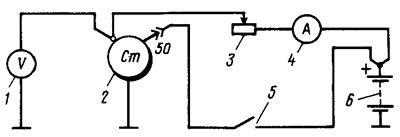
Pic. 135. Connection diagram for testing the starter on the stand: 1 - voltmeter with a scale limit of at least 15 V; 2 - starter; 3 - 800 A rheostat; 4 - ammeter with shunt for 1000 A; 5 - switch; 6 - battery
Health check
With a current source voltage of 12 V, closing switch 5 (see fig. 135), make three starts of the starter with different braking conditions. For example, with braking torques: 0.20-0.24; 0.55-0.66 and 0.90-1.08 kgf-m. The duration of each starter activation should be no more than 5 s, and the intervals between starts should be at least 5 s.
If the starter does not rotate the ring gear of the stand or its operation is accompanied by abnormal noise, then the starter is disassembled and its parts are checked.
Full brake test
The ring gear of the stand is braked, the starter is turned on and the current strength, voltage and braking torque are measured, which should be no more than 500 A, no more than 7 V and no less than 1.4 kgf-m, respectively. The duration of the starter activation should be no more than 5 s.
If the braking torque is lower, and the current strength is higher than the specified values, then the interturn short circuit in the stator or armature winding or the short circuit of the windings to the housing may be the reason for this.
When the braking torque and current consumption are below the above values, the causes may be oxidation and contamination of the collector, severe wear of the brushes or a decrease in the elasticity of their springs, brushes hanging in the brush holders, loosening of the stator winding leads, oxidation or burning of the contact bolts of the traction relay.
When the gear is fully braked, the starter armature should not rotate. If this happens, the freewheel is defective. To troubleshoot, disassemble the starter and replace damaged parts.
Idling test
The ring gear of the stand is disengaged from the starter gear. The starter is turned on and the consumed current and armature speed are measured, which should be no more than 60 A and 5000±500 rpm, respectively, at a voltage at the starter terminals of 11.5-12 V.
If the current strength and armature speed differ from the indicated values, then the reasons may be the same as in the previous test.
Checking the traction relay
Installed between restrictive ring 1 (see fig. 133) and gear spacer 12.8 mm thick and include a relay. The switching voltage of the relay when the gear rests on the gasket should be no more than 9 V at ambient temperature (20±5) °C If the voltage is higher, then this indicates a malfunction of the relay or actuator.
